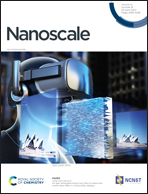Synergetic effect in rolling GaIn alloy droplets enables ultralow temperature growth of silicon nanowires at 70 °C on plastics†
Abstract
Ultralow temperature growth of silicon nanowires (SiNWs) directly upon cheap plastics is highly desirable for building high performance soft logics and sensors based on mature Si technology. In this work, a low temperature growth of SiNWs at only 70 °C has been demonstrated for the first time, upon polyethylene terephthalate plastics, by using gallium–indium (GaIn) alloy droplets that consume an amorphous Si (a-Si) layer as the precursor. The GaIn alloy droplets enable a beneficial synergetic effect that helps not only to reduce the melting temperature, but also to install a protective Gibbs adsorption layer of In atoms, which are critical to stabilize the rolling catalyst droplet, against otherwise rapid diffusion loss of Ga into the a-Si matrix. Ultra-long SiNWs can be batch-produced with a precise location and preferred elastic geometry, which paves the way for large scale integration. At <70 °C, a transition from rolling to sprawling dynamics is observed by in situ scanning electron microscopy, caused by reduced diffusion transport and rapid formation of discrete nuclei in the alloy droplet, which provides the basis for continuous growth of SiNWs. This unique capability and critical new understanding open the way for integrating high quality c-Si electronics directly over flexible, lightweight and extremely low cost plastics.



 Please wait while we load your content...
Please wait while we load your content...